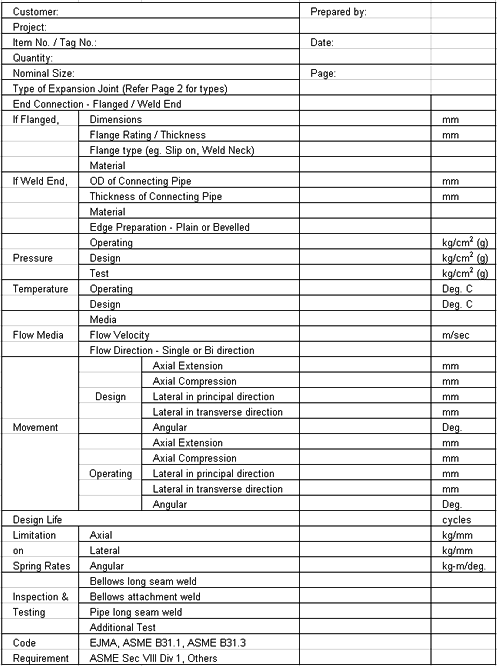Review to determine the location of Expansion Joints
Review the availability of supporting structures for anchoring / guiding of the piping
Review the magnitude and direction of thermal movements to be compensated while selecting the location and type of Expansion Joint
Review to incorporate special hardware to prevent the torsional rotation of Bellows
Specify the Bellows material compatible for flow medium
Considerations to be given for,
- The possibility of Chloride ion stress corrosion in Austenitic Stainless steel.
- The possibility of Caustic induced stress corrosion in Nickel alloys.
- The possibility of leaching of corrodents from insulating materials.
Indicate details of flow medium such as,
Velocity of Flow medium
The velocity is required as a thicker sleeve is required if the flow velocity is higher to prevent the turbulence and Resonance vibration
Density of flow medium
Certain flow material will settle and pack in between the convolutions resulting in pre-mature failure. Hence it is important to take the Density into consideration while designing expansion Joints.
Composition of Flow medium
This is required to check the compatibility of material used in the Expansion Joint assembly
Direction of Flow medium
A bidirectional flow requires a telescopic type of sleeve and / or higher thickness sleeve to prevent buckling due to back flow and to prevent the damage of the Bellows. Hence it is better to specify if the direction of flow is single directional or bi-directional.
The system design and test pressures should be specified.
Excess Bellows thickness is required to withstand the higher pressures.
If high thickness is used where unnecessary this will produce adverse effect on Bellows fatigue life and result in low flexibility.
Maximum, minimum and installation temperatures should be specified accurately.
Pre-positioning / pre-stressing of the Expansion Joint during installation shall be required in case of significant variation in the ambient temperature.
The system designer shall specify the movements of connecting equipments / anchors and mis-alignment (if any) in addition to the thermal movement of the piping.
Similar to pressure, the movements being specified should be realistic. Adding excessive safety factor requires the Bellows of higher number of convolutions compromising the Bellows stability.
If required to be performed at site, the details shall be provided to consider the weight of the same in the design.
Specify the amplitude and frequency of vibration to be imposed on Bellows such as those caused by machineries such as pumps, blowers etc.
A resonant condition in the Bellows will result in cracking and failure.
Specify the additional weight requirements and safety factors where required to design Lifting Lugs.
Other details which may affect the performance of the Expansion joint such as environmental details (saline atmosphere, atmosphere contaminated with SO2 etc.) shall also be included.
In cases of hazardous flow medium / very high pressures, it is desired to specify higher thickness external cover to prevent the radial escape of flow medium and to prevent the harm to working personnel.
Specifying limit rods will prevent the Bellows from stretching out and getting damaged in the event of failure of main anchors.
A 2 – ply testable Bellows, with each ply designed to withstand the specified conditions. The annular space between the plys can be monitored for leakage and can be planned to replace the joint in the next scheduled maintenance.
Please specify if this is a requirement.
ORDERING INFORMATION / SPECIFICATION SHEET FOR CIRCULAR BELLOWS EXPANSION JOINT
